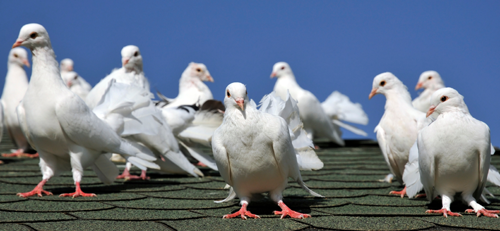
Many homeowners have problems with birds around the outside of their garage. That’s because, if a garage is not attached to the home, you won’t hear birds pecking and nesting on rooftop areas, or even the gutters of a garage.
Bird droppings, debris and other nesting materials can accumulate to do long-term damage to the roof and other areas of your garage. Unless you deter them with effective bird control devices, birds will eventually consider your garage a safe haven and gather in increasing numbers. Keep in mind that it costs just as much to repair a garage roof as it does the roof on your home. And cleaning bird nests and debris out of rain gutters around your garage is no less of a chore than it is for gutters that surround your home Fortunately, there are a number of humane and effective bird deterrents that you can use to keep birds away from your garage. Here's what the pros recommend.They’ll slip ‘n slid on Bird SlopeEasy to install, Bird Slope consists of slippery PVC panels that won't allow birds to get a solid footing under the eaves of your garage. After a few frantic tires to land or perch, birds give up and move on to your neighbor’s garage. The best bird slope panels are UV protected and sun- and weather-resistant to last longer--a good idea if you live in a severe weather area. Bird slope works against all types of birds--swallows, starlings, pigeons, etc. The panels blend in with most architectural styles and even come in two colors--stone and grey.They can’t penetrate Garden Bird Netting Drape this lightweight, easy-to-handle mesh along the sides of your garage and forget about pest birds. Garden Bird Netting comes in 14 x 100-foot and 14 x 200-foot rolls and is easily cut to the size you need. It comes in three "mesh" sizes--1/4", 1/2" and 3/4". Use the bird netting clips that the manufacturer recommends to streamline installation. The best netting is made from durable, UV-protected polypropylene. Copper Stuf-Fit Mesh—for small holesIf your garage has lots of little crevices, holes and nooks where birds can settle in, Copper Stuf-Fit mesh is what you need. The mesh comes in 20-foot and 100-foot roles and can be easily “formed” into the shape you need to block out even the most determined bird. This handy mesh is also ideal for keeping birds from working their way under roofing tiles, retractable awnings, and where pipes enter siding or foundations. No Nasty Nest—for SwallowsIf you’ve got swallow nests covering the sides of your garage, you need No Nasty Nest. This hanging "twine" bird deterrent makes it a real chore for birds to gain access to nesting sites. Installation is a snap. Each strip of No Nasty Nest features a self-adhesive back for fast installation on eaves, entryways and other elevated exterior areas of your garage.